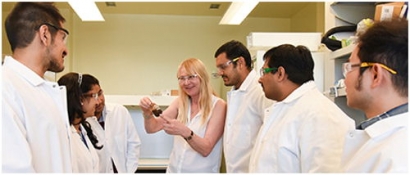
Converting algae to biofuels is a two-step process. The first step, hydrothermal liquefaction, was developed by PNNL. It involves applying high pressure and high temperature to algae to create bio oil. In the process, it produces waste — approximately 25 to 40 % of carbon and 80 % of nutrients from the algae are left behind in wastewater streams.
The wastewater is hard to process however, Birgitte K. Ahring, professor at WSU Tri-Cities’ Bioproducts, Sciences and Engineering Laboratory, and her team, have found that adapting anaerobic microbes to break down the remaining residue is a viable option.
Through this process, the material becomes degradable and gets transformed into a bionatural gas without the use of harsh chemicals. The solid material that remains can also be applied as a fertilizer or recycled back into the hydrothermal liquefaction process for further use.
The results of the team’s research are published this month in Bioresource Technology. Also on the team are: Keerthi Srinivas, WSU postdoctoral research associate; Sebastian Fernandez, WSU research assistant; Andrew Schmidt, of PNNL’s chemical and biological processes development group; and, Marie Swita, of PNNL’s chemical and biological processes development group.
“It has always been my mantra that we shouldn’t waste waste,” Ahring said. “We had an idea that we could turn this waste product into something useful, such as a fertilizer. Our findings revealed that we could use this waste product as something much more.”
The ability to convert a waste product into a usable commodity provides algal biorefineries with a solution to a large problem, Ahring said.
She said the team’s results were so promising that they are now partnering with PNNL on its conversion of sewage sludge to fuel using a similar strategy for the wastewater.
“Today, sewage sludge is found throughout the world,” Ahring said. “Creating a process to produce biofuels, bio-natural gas, and nutrients from this material would be of major importance. The current study has demonstrated that nothing should ever be regarded as a waste, but instead as a resource.”
Photo: WSU Professor Birgitte Ahring, center, points to test sample, with her research team (WSU)

